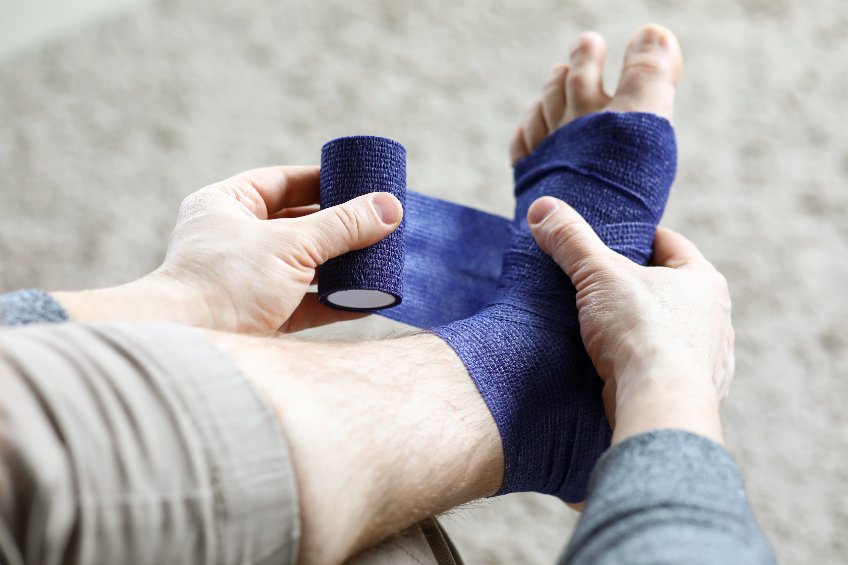Stressed About Ankle Arthroscopy?
A patient may require surgery for chronic foot or ankle pain that does not respond to treatment. A doctor may recommend ankle arthroscopy to treat the issue. Feeling anxious, stressed, or overwhelmed about surgery is understandable. There are often many moving parts and a possible risk of complications. Furthermore, some patients may not fully understand what happens during surgery. Asking the surgeon for a step-by-step account of the process helps patients feel more at ease.

Persistent ankle pain
Millions of Americans have foot or ankle pain, but not all require treatment. Surgery is often necessary for chronic conditions, sudden injuries, or joints that do not respond to treatment. The joints, ligaments, and muscles help with shock absorption and weight distribution when the foot strikes the ground. If the bones or ligaments are compromised, pain, stiffness, weakness, and discomfort can occur. Arthritis, the wear and tear of ligaments and bone, is the most common reason for foot pain. Injuries like fractures and ligament tears can happen during sports, falls, or accidents. These events can cause scar tissue, bone spurs, loose cartilage, or nerve pain to develop.
Outpatient surgery
Ankle arthroscopy is a minimally invasive procedure that can diagnose and treat ankle or foot damage. The surgery is growing in popularity as there are minor incisions, faster turnaround time, and less pain. During the procedure, a surgeon uses an arthroscope, a long and thin device with a light and camera at the end. The camera magnifies and sends images to a screen, which helps the surgeon assess the ankle. From there, the surgeon can fix the issue without causing further damage to the foot. The surgeon may fuse joints, remove scar tissue, or repair ligaments based on the injury.
What happens during the procedure?
Most arthroscopy procedures happen at ambulatory surgical centers or hospitals with outpatient facilities. This allows the patient to leave on the same day and start recovery. The surgery begins by prepping the patient and marking incision locations on the foot. In most cases, surgeons repair the subtalar joint or the larger synovial joint. The patient receives anesthesia, and the first incision is made near the back or side of the foot. A liquid or gas is passed through the incision to help the surgeon see clearly. The arthroscope can help the surgeon assess the ligaments, joints, and bones.
Repairing the ankle
If there is damage, the procedure continues with another incision made to insert surgical tools. The surgeon can remove bone spurs, damaged cartilage, or scar tissue. These small tools are versatile, allowing for easy removal. Some procedures may require moving ligaments or ankle fusion. With fusion, the doctor will insert a pre-prepared bone graft, then hold the ankle in place with screws. Once the procedure is complete, the incisions are closed, and the foot is bandaged.
Getting active
Ankle arthroscopy recovery depends on the severity of the injury. Minimally invasive surgery means recovery time is much shorter than open surgery. However, there will be at least 2 weeks with the foot immobilized. The foot will be in a cast during this time, then move to a boot after 2 weeks. Physical therapy and pain management are essential to recovery and happen over several weeks post-operation. On average, patients can resume movement and simple exercises within 3 months. Fusions take longer, needing 6 or more months to fuse fully.
Improving outcomes
Being prepared for the process is the best way to reduce overwhelm. Start by learning as much about the process as possible to be mentally prepared for surgery. Adopting a healthy diet and a doctor-approved exercise program can help with surgery and recovery. Comparative studies show that the minimally invasive arthroscopy procedure has a higher success rate than open surgery. Arthroscopy may be a necessary step for advanced injuries or conditions, but the results are undeniable.
Can Lower Back Pain Return After Spinal Surgery? 3 Lifestyle Changes To Get The Most Out Of Fusion
Minnesota Valley Valley Center2024-04-02T14:49:38-05:00April 15th, 2024|
Spinal surgery is an excellent solution for lower back pain, but symptoms can return. With lifestyle changes, patients can get the most out of fusion.
A New Lease On Life: Exploring How Robotic Total Joint Replacement Can Get You Active Again
Minnesota Valley Valley Center2024-03-24T17:38:47-05:00March 29th, 2024|
Robotic total joint replacement uses a robotic arm to replace the joint. This innovative approach allows a quick return to activities.
Restoring Dexterity: How Outpatient Carpal Tunnel Surgery Can Change Your Life
Minnesota Valley Valley Center2024-03-24T17:38:37-05:00March 15th, 2024|
After months of wrist and hand pain, carpal tunnel surgery may be needed. With outpatient options, restored dexterity with less pain and discomfort is possible.
More Articles from MVSC
December 14, 2023
Ankle pain is common, but sometimes arthritis is at play. An orthopedic surgeon may recommend subtalar fusion for patients.
November 28, 2023
Is bunionectomy a solution for foot pain caused by bunions? Learn about surgical and non-surgical options before a decision.
September 26, 2023
An Achilles tendon recovery timeline can be long and grueling. With rest and physical therapy, patients can see faster results.
September 19, 2023
Big toe arthritis can cause severe discomfort if left untreated. Hallux rigidus repair can provide extensive relief for patients.










